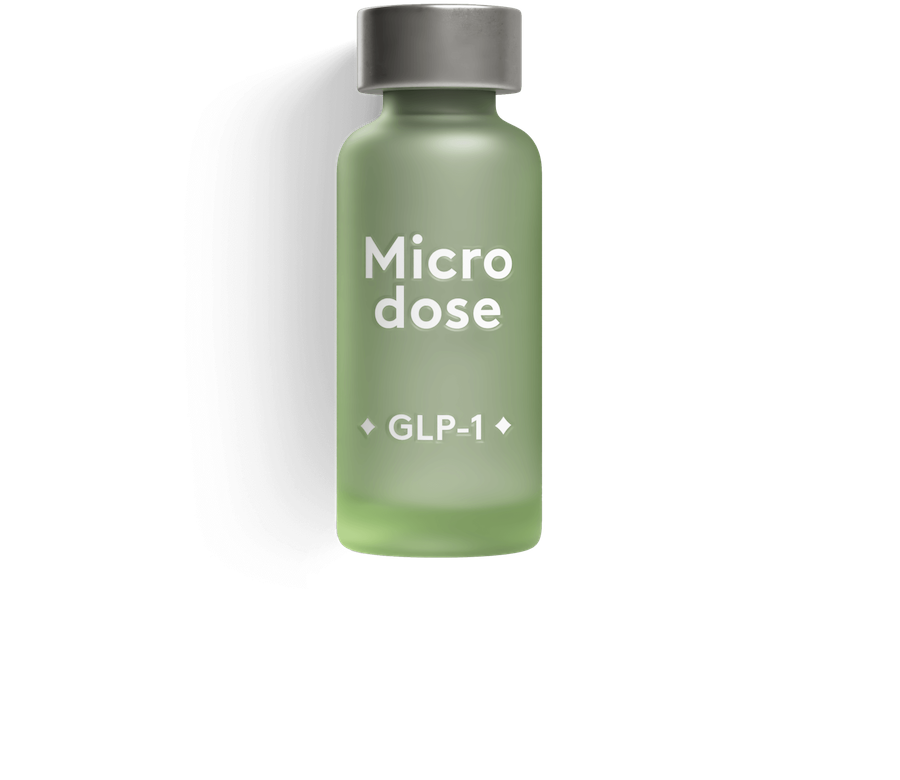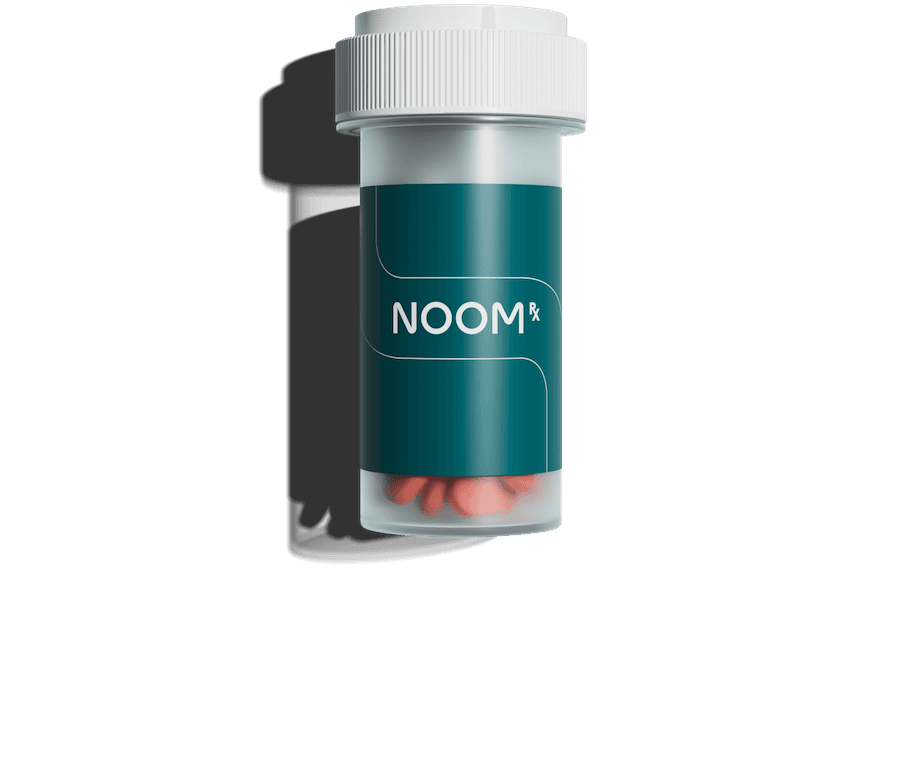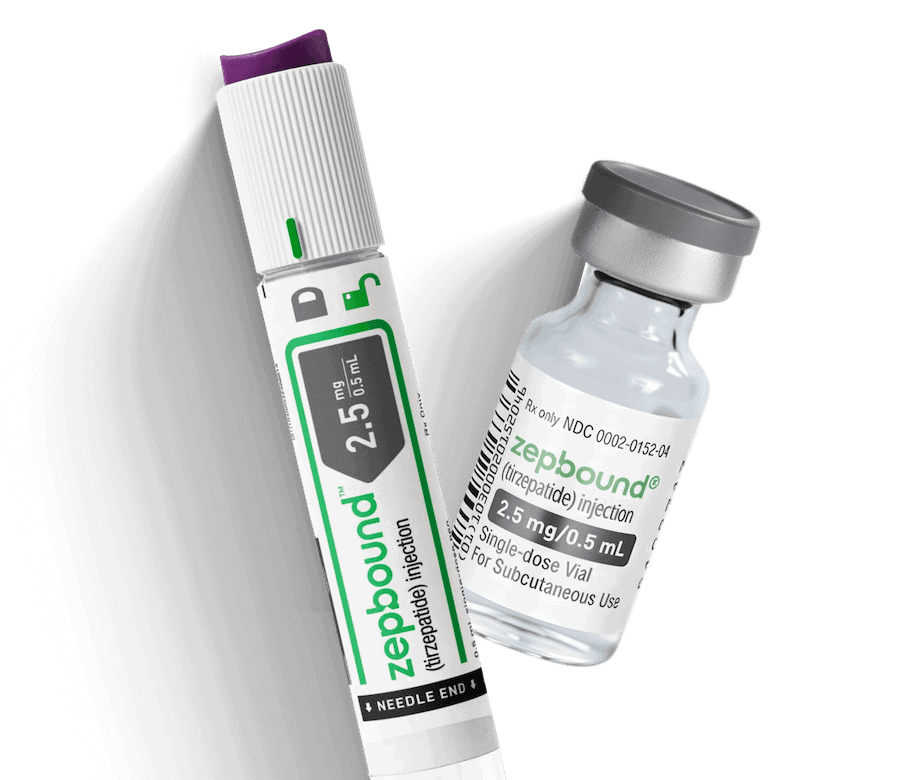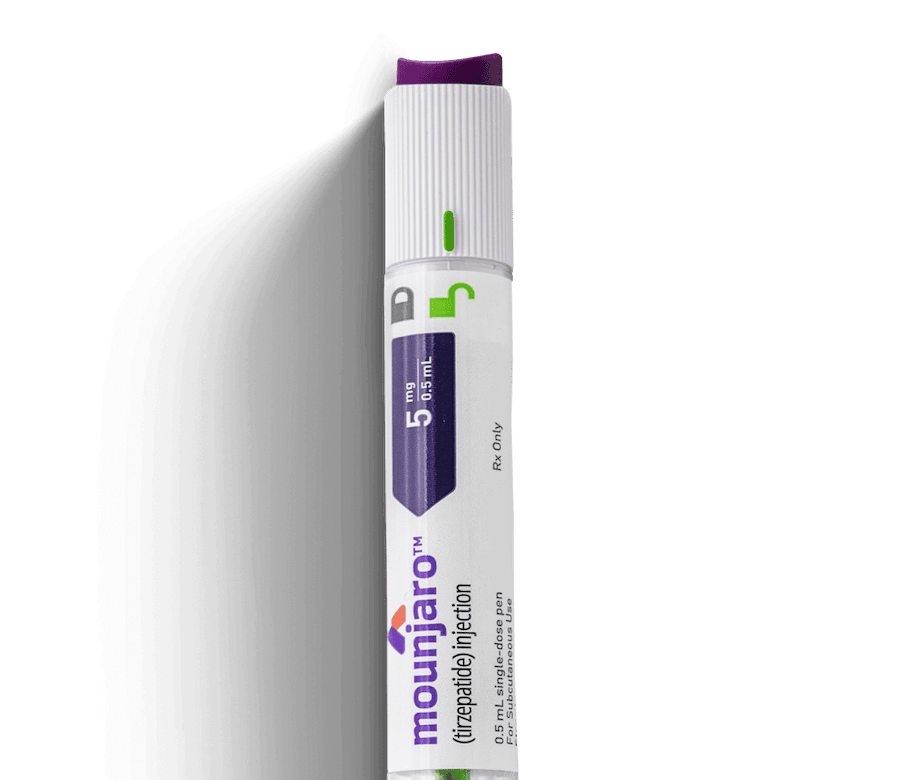What you’ll learn:
- Qsymia® is a once-daily pill that combines two medications, phentermine and topiramate, to help reduce appetite and support weight loss.
- Its most common side effects include tingling sensations, dry mouth, and changes in mood or sleep patterns.
- Compared to GLP-1 medications, Qsymia® typically causes fewer digestive issues but may lead to more sensory or mood-related side effects.
For some people, losing meaningful weight means getting prescription support. And these days, there are lots of weight loss medications to consider. While most people are familiar with GLP-1 medications, like Wegovy® and Zepbound®, Qsymia® is another option. Qsymia® is a pill you take once a day, as opposed to the weekly injection with GLP-1s. But, it’s good to know about possible side effects before considering Qsymia®.
Qsymia® is a combination of two medications, phentermine and topiramate. Each of these medications works in a different way to help lower appetite and help you lose weight alongside healthy lifestyle changes, like diet and exercise.
Each one also has unique side effects you might experience when you first start the medication or as your dose increases. Let’s go through what you can expect to see if it could be the right medication for you.
Rx weight-loss, the right way, with Noom
Get access to prescription weight loss medication with Noom.How Qsymia® affects your body
The phentermine and topiramate in Qsymia® work together to help support weight loss. Both target different areas of the body and brain involved in appetite and eating habits. Here’s what we know and why they can cause side effects:
- Phentermine is a stimulant that affects the central nervous system. It’s believed to help reduce appetite by increasing levels of certain brain chemicals that regulate hunger cues. Because it’s a stimulant, some people may experience side effects like increased heart rate, elevated blood pressure, restlessness, or trouble sleeping.
- Topiramate, a medication also used for seizures and migraines, appears to influence several pathways related to appetite and satiety. Because it affects the nervous system, it can cause side effects such as tingling sensations, dizziness, trouble concentrating, or mood changes.
Together, these effects may help reduce appetite, improve satiety, and support more consistent eating patterns over time.
Sign up for Noom Digest!
Stay on top of your wellness journey with the latest Noom news, thoughtful articles, and a healthy dose of inspiration delivered right to your inbox.How it’s taken
Qsymia® is taken following a step-up dosing plan to limit side effects and get your body used to the medication. People start with the lowest dose, and it is increased over time, based on how your body responds.
Here’s the typical Qsymia® dose progression:
| Dose (phentermine/topiramate) | Schedule | Step up notes |
|---|---|---|
| 3.75 mg / 23 mg | Weeks 1-2 | This initial dose gives your body time to get used to the medication before increasing. |
| 7.5 mg / 46 mg | Weeks 3-14 | If a person responds well to the introductory dose, most move up to this amount and remain at it. At the 12-week mark, your provider will check progress; if weight loss is under 3%, they may adjust or discontinue treatment. |
| 11.25 mg / 69 mg | After week 14 | This dose is used as a short, two-week transition for those moving up to the highest dose for most weight loss benefits. |
| 15 mg / 92 mg | After week 14 (if needed) | This is the maximum dose. If weight loss is under 5% after 12 weeks at this level, your doctor will usually stop treatment. |
Common side effects of Qsymia®
In clinical trials, side effects with Qsymia® tended to increase with higher doses, often showing up as changes in how your brain and nervous system respond, along with some digestion-related symptoms.
Here’s a quick look at how often these side effects showed up in adults and some general tips to manage them:
Nervous system side effects
Some people reported sensations or changes tied to the nervous system. These symptoms can feel strange but are typically manageable.
| Symptom | Qsymia® (3.75 mg/23 mg) | Qsymia® (7.5 mg/46 mg) | Qsymia® (15 mg/92 mg) | What can help |
|---|---|---|---|---|
| Paresthesia (tingling or pins and needles) | 4% | 14% | 20% | Gentle stretching or moving around may ease discomfort. Let your provider know if it’s persistent. |
| Headache | 10% | 7% | 11% | Stay hydrated and take breaks from screens or bright lights. |
| Dysgeusia (taste changes) | 1% | 7% | 9% | Rinsing your mouth or chewing minty gum might help with unusual tastes. |
| Dizziness | 3% | 7% | 9% | Stand up slowly and make sure you’re eating regularly. |
| Disturbance in attention | 0.4% | 2% | 4% | Prioritize rest and let your provider know if focus issues interfere with daily tasks. |
Psychiatric side effects
There were also reports of mood-related side effects. While these are manageable, it’s worth discussing any mental health changes with your provider.
| Symptom | Qsymia® (3.75 mg/23 mg) | Qsymia® (7.5 mg/46 mg) | Qsymia® (15 mg/92 mg) | What can help |
|---|---|---|---|---|
| Insomnia | 5% | 6% | 9% | Try using calming techniques and limiting screen time before bed. |
| Depression | 3% | 3% | 4% | Track changes in mood and talk with your provider if symptoms persist. |
| Anxiety | 3% | 2% | 4% | Calming routines like gentle movement, breathing exercises, or talking to someone can help. |
| Irritability | 2% | 3% | 4% | Keep a mood log and flag patterns to your provider for guidance. |
Gastrointestinal issues
Digestive-related symptoms were fairly common in the trial group. Most were mild to moderate and improved over time.
| Symptom | Qsymia® (3.75 mg/23 mg) | Qsymia® (7.5 mg/46 mg) | Qsymia® (15 mg/92 mg) | What can help |
|---|---|---|---|---|
| Dry mouth | 7% | 14% | 19% | Sip water regularly to keep your mouth moist. |
| Constipation | 8% | 15% | 16% | Slowly add fiber to your diet, move more during the day, and drink plenty of water. |
| Nausea | 6% | 4% | 7% | Eat smaller meals and avoid rich or greasy foods. |
| Diarrhea | 5% | 6% | 6% | Stick to bland foods like rice or toast and stay hydrated. |
Other symptoms
Other side effects included fatigue and blurred vision. If either becomes bothersome or doesn’t ease up with time, it’s a good idea to bring it up with your provider.
| Symptom | Qsymia® (3.75 mg/23 mg) | Qsymia® (7.5 mg/46 mg) | Qsymia® (15 mg/92 mg) | What can help |
|---|---|---|---|---|
| Fatigue | 5% | 4% | 6% | Take breaks throughout the day and prioritize consistent, quality sleep. |
| Blurred vision | 6% | 4% | 5% | Rest your eyes often and tell your provider if changes in vision persist. |
Side effects of stopping Qsymia®
If you’re thinking about stopping Qsymia®, it’s important to have a plan in place with your provider. Sudden discontinuation can increase the risk of seizures, especially if you’re taking the highest dose and have been on the medication for a while.
Here are a few tips to keep in mind if you’re discontinuing Qsymia®:
- Don’t stop on your own. Talk to your provider first, as they can help you decide if it’s the right time and how to do it safely.
- If you’re on the highest dose (15 mg/92 mg), your provider may recommend taking it every other day for at least one week before stopping completely.
- Expect monitoring. Your provider may track your symptoms during the tapering process to make sure everything stays on track.
- Weight loss goals matter. If you haven’t lost a meaningful amount of weight after 12 weeks on the highest dose, your provider may suggest stopping the medication.
Gradually tapering off allows your body to adjust and can reduce the risk of side effects during the transition.
Qsymia® side effects in females
There aren’t any known side effects from Qsymia® that appear more frequently in women, but there are still important considerations to keep in mind. Qsymia® isn’t safe to use during pregnancy.
If you’re planning to become pregnant or think you might be, you’ll need to stop the medication beforehand. You also shouldn’t use it while breastfeeding.
Qsymia®: Severe side effects and safety warnings
Qsymia® can help you lose weight, but it’s important to know the serious risks that can come with it. Being aware helps you spot early warning signs and take action if something changes.
Here are some of the more serious side effects linked to Qsymia®:
- Mood and behavior changes: If you experience anxiety, depression, irritability, aggression, or thoughts of self-harm, get emergency medical help.
- Thinking and speech difficulties: If you notice slowed thinking, memory problems, trouble focusing, or difficulty finding words, let your healthcare provider know as soon as possible.
- Metabolic acidosis: Seek immediate care if you have rapid or deep breathing, unusual tiredness, irregular heartbeat, nausea, or confusion.
- Kidney issues: Contact your provider promptly if you develop sharp pain in the lower back or side, painful urination, changes in urine color, or blood in the urine.
- Seizures: If you have a seizure after starting, stopping, or changing your dose, call emergency services right away.
- Decreased sweating and overheating: Report fever, flushing, or feeling unusually hot to your provider, especially in warm weather.
- Allergic and skin reactions: Get emergency help if you have a rash, hives, swelling of the face or throat, difficulty breathing, or blistering skin.
The best way to stay safe is to stay in close communication with your provider, especially if anything changes in how you feel or if you’re starting or stopping other medications.
Who shouldn’t take Qsymia®?
Before starting Qsymia®, make sure it’s the right option for your health history and current medications. You should avoid Qsymia® if any of the following apply to you:
You shouldn’t take Qsymia® if you:
- Are pregnant or planning to become pregnant
- Have glaucoma
- Have an overactive thyroid (hyperthyroidism)
- Are currently taking or have taken MAOIs in the last 14 days
- Have had an allergic reaction to phentermine, topiramate, or any of Qsymia®’s ingredients, including FD&C Yellow No. 5
If you have any of the following health concerns, talk to your healthcare provider before starting Qsymia®:
- A history of seizures
- Kidney stones
- Liver or kidney disease
- Mood-related side effects from past treatments
- Heart conditions or arrhythmias
- Use of alcohol or multiple medications that may interact
Always review your full medical history with your provider so they can help you weigh the potential benefits and risks for your situation.
Comparing Qsymia® to GLP-1 drugs
While both Qsymia® and GLP-1 medications can support weight loss, they work through different systems in the body, and that can shape the kinds of side effects people experience. Qsymia® primarily acts through the brain, while GLP-1s work more directly in the digestive system.
Here’s a side-by-side look at how Qsymia® compares to other GLP-1 medications when it comes to commonly reported side effects:
| Symptom | Phentermine/topiramate ER (15 mg/92 mg) – Qsymia® | Semaglutide (2.4 mg) – Wegovy® | Tirzepatide (15 mg) – Zepbound® | Liraglutide (3 mg) – Saxenda® |
|---|---|---|---|---|
| Paresthesia | 20% | Not reported | Not reported | Not reported |
| Dry mouth | 19% | Not reported | Not reported | 2% |
| Headache | 11% | 14% | Not reported | 14% |
| Dysgeusia | 9% | Not reported | Not reported | Not reported |
| Dizziness | 9% | 8% | 4% | 7% |
| Insomnia | 9% | Not reported | Not reported | 2% |
| Fatigue | 6% | 11% | 7% | 8% |
| Nausea | 7% | 44% | 28% | 39% |
| Vomiting | Not reported | 24% | 13% | 15% |
| Diarrhea | 6% | 30% | 23% | 21% |
| Constipation | 16% | 24% | 11% | 19% |
| Dyspepsia | Not reported | 9% | 10% | 9% |
What explains the difference in side effects?
GLP-1 medications activate receptors in the gut that slow digestion and influence hunger hormones, which is why stomach-related side effects like nausea and diarrhea are more common. As your digestive system adjusts, these can lessen over time, but they tend to be a hallmark of this medication class.
Qsymia® acts on the central nervous system to reduce hunger and enhance feelings of fullness. Because of this, it tends to be associated with sensory and neurological side effects, such as changes in sensation, taste, or sleep patterns. It’s a different mechanism with a different side effect profile to match.
Understanding how each type of medication interacts with your body can help you and your provider choose an option that fits your lifestyle and comfort level.
Weight loss potential: Qsymia® vs GLP-1s
While side effects are one part of the decision-making process, you may also want to know how much weight you can lose with each option. Here’s a quick look at the average weight loss results reported in clinical trials for Qsymia® and commonly used GLP-1 medications at their highest approved doses:
| Medication | Effectiveness |
|---|---|
| Phentermine/topiramate ER (15 mg/92 mg) – Qsymia® | 14% (56 weeks) |
| Semaglutide (2.4 mg) – Wegovy® | 15% (68 weeks) |
| Tirzepatide (15 mg) – Zepbound® | 21% (72 weeks) |
| Liraglutide (3 mg) – Saxenda® | 5% (52 weeks) |
Frequently asked questions (FAQs) about Qsymia® side effects
Here are the most common concerns people share with their healthcare providers and online communities.
How quickly do you lose weight on Qsymia®?
A study shows that noticeable weight loss can begin within about 8 weeks of starting Qsymia®. Your provider will typically reassess your progress around the 12-week mark. If you haven’t lost at least 3% of your starting weight by then, they may adjust your dose upward in stages to help support continued weight loss.
How long do Qsymia® side effects last?
Most of the common side effects tend to be strongest during the first few weeks of treatment and often improve as your body adjusts to the medication. If side effects persist or worsen after this adjustment period, it’s worth discussing with your care team whether dosage changes or other strategies might help.
Which is better, Wegovy® or Qsymia®?
Both medications can be effective for weight loss, but they work differently and have distinct advantages. Qsymia® is taken as a daily pill and may be more convenient for some people, while Wegovy® is taken as a weekly injection. The average weight loss rates between the two are similar, but Wegovy may have additional heart health benefits. The choice often depends on your personal preferences, medical history, insurance coverage, and how well you tolerate each medication.
How much does Qsymia® cost per month?
Qsymia® typically costs $250-$300 per month for a 30-day supply, while the generic version runs around $200-$250. This can vary depending on your pharmacy and location. Eligible people can save $70-$75 monthly with the Qsymia® Savings Card, or opt for $98 flat-rate home delivery through Qsymia® Engage.
Is there a generic for Qsymia®?
Yes, a generic version of Qsymia® was launched in the U.S. in May 2025 and is manufactured by Teva Pharmaceuticals. This generic contains the same active ingredients, phentermine and topiramate extended-release.
The bottom line: Exploring weight loss with Qsymia®
Qsymia® offers an alternative to GLP-1 medications, not only in how it works, but also in the types of side effects you might experience. It’s also a once-daily capsule instead of a weekly injection, which might appeal to people looking for a non-injectable weight loss option with a different mechanism of action.
Regardless of which medication you choose, consistent lifestyle habits still matter. Balanced eating and regular movement play a major role in keeping weight off and supporting your overall health for the long run. If you’re interested in learning more about medications for weight loss, see if you qualify for Noom Med. You’ll be paired with a clinician who can help you explore the options and prescribe them if needed. Then they’ll tailor a plan to your goals, monitor your experience, and ensure you’re getting support every step of the way.
Why you can trust us
At Noom, we’re committed to providing health information that’s grounded in reliable science and expert review. Our content is created with the support of qualified professionals and based on well-established research from trusted medical and scientific organizations. Learn more about the experts behind our content on our Health Expert Team page.












